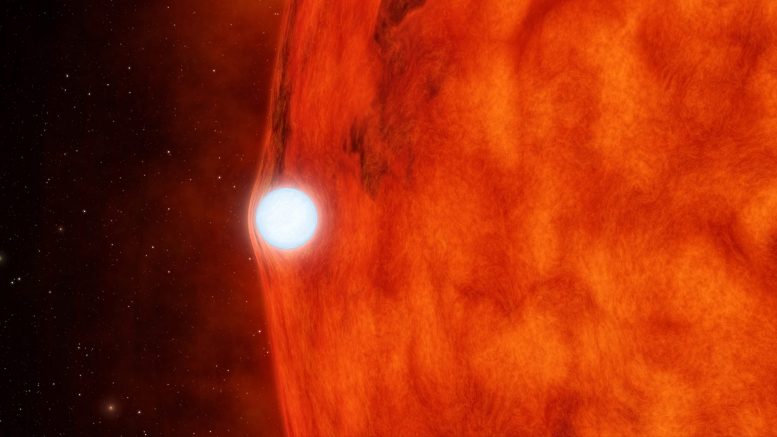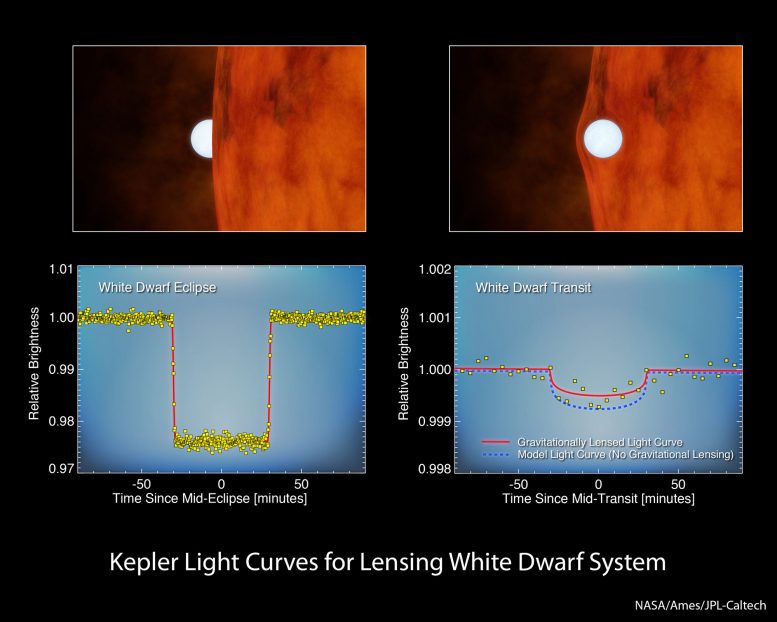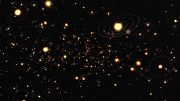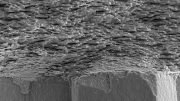
This artist’s concept depicts a dense, dead star called a white dwarf crossing in front of a small, red star. The white dwarf’s gravity is so great it bends and magnifies light from the red star.
NASA’s Kepler space telescope observed this effect in a double-star system called KOI-256 by monitoring changes in the red star’s brightness. The red dwarf star is cooler and redder than our yellow sun. Its companion is a white dwarf, the burnt-out core of a star that used to be like our sun. Though the white dwarf is about the same diameter as Earth, 40 times smaller than the red dwarf, it is slightly more massive. The two objects circle around each other, but because the red dwarf is a bit less massive, it technically orbits the white dwarf.
Kepler is designed to look for planets by monitoring the brightness of stars. If planets cross in front of the stars, the starlight will periodically dip. In this case, the passing object turned out to be a white dwarf, not a planet. The finding was serendipitous for astronomers because it allowed them to measure the tiny “gravitational lensing” effect of the white dwarf, a rarely observed phenomenon and a test of Einstein’s theory of relativity. These data also helped to precisely measure the white dwarf’s mass.
Credit: NASA/JPL-Caltech
In a new study, astronomers witnessed the effects of a white dwarf bending the light of its companion star in a double-star system called KOI-256, allowing them to measure the tiny “gravitational lensing” effect of the white dwarf, testing of Einstein’s theory of relativity.
NASA’s Kepler space telescope has witnessed the effects of a dead star bending the light of its companion star. The findings are among the first detections of this phenomenon — a result of Einstein’s general theory of relativity — in binary, or double, star systems.
The dead star, called a white dwarf, is the burnt-out core of what used to be a star like our sun. It is locked in an orbiting dance with its partner, a small “red dwarf” star. While the tiny white dwarf is physically smaller than the red dwarf, it is more massive.
“This white dwarf is about the size of Earth but has the mass of the sun,” said Phil Muirhead of the California Institute of Technology, Pasadena, lead author of the findings published in the Astrophysical Journal. “It’s so hefty that the red dwarf, though larger in physical size, is circling around the white dwarf.”
Kepler’s primary job is to scan stars in search of orbiting planets. As the planets pass by, they block the starlight by minuscule amounts, which Kepler’s sensitive detectors can see.
This artist’s animation depicts an ultra-dense dead star, called a white dwarf, passing in front of a small red star. As the white dwarf crosses in front, its gravity is so great that it bends and magnifies the light of the red star.
“The technique is equivalent to spotting a flea on a light bulb 3,000 miles away, roughly the distance from Los Angeles to New York City,” said Avi Shporer, co-author of the study, also of Caltech.
Muirhead and his colleagues regularly use public Kepler data to search for and confirm planets around smaller stars, the red dwarfs, also known as M dwarfs. These stars are cooler and redder than our yellow sun. When the team first looked at the Kepler data for a target called KOI-256, they thought they were looking at a huge gas giant planet eclipsing the red dwarf.
“We saw what appeared to be huge dips in the light from the star, and suspected it was from a giant planet, roughly the size of Jupiter, passing in front,” said Muirhead.
To learn more about the star system, Muirhead and his colleagues turned to the Hale Telescope at Palomar Observatory near San Diego. Using a technique called radial velocity, they discovered that the red dwarf was wobbling around like a spinning top. The wobble was far too big to be caused by the tug of a planet. That is when they knew they were looking at a massive white dwarf passing behind the red dwarf, rather than a gas giant passing in front.
The team also incorporated ultraviolet measurements of KOI-256 taken by the Galaxy Evolution Explorer (GALEX), a NASA space telescope now operated by the California Institute of Technology in Pasadena. The GALEX observations, led by Cornell University, Ithaca, N.Y., are part of an ongoing program to measure ultraviolet activity in all the stars in Kepler field of view, an indicator of potential habitability for planets in the systems. These data revealed the red dwarf is very active, consistent with being “spun-up” by the orbit of the more massive white dwarf.
The astronomers then went back to the Kepler data and were surprised by what they saw. When the white dwarf passed in front of its star, its gravity caused the starlight to bend and brighten by measurable effects.
“Only Kepler could detect this tiny, tiny effect,” said Doug Hudgins, the Kepler program scientist at NASA Headquarters, Washington. “But with this detection, we are witnessing Einstein’s general theory of relativity at play in a far-flung star system.”
One of the consequences of Einstein’s general theory of relativity is that gravity bends light. Astronomers regularly observe this phenomenon, often called gravitational lensing, in our galaxy and beyond. For example, the light from a distant galaxy can be bent and magnified by matter in front of it. This reveals new information about dark matter and dark energy, two mysterious ingredients in our universe.

This chart shows data from NASA’s Kepler space telescope, which looks for planets by monitoring changes in the brightness of stars. As planets orbit in front of a star, they block the starlight, causing periodic dips. The plot on the left shows data collected by Kepler for a star called KOI-256, which is a small red dwarf. At first, astronomers thought the dip in starlight was due to a large planet passing in front of the star. But certain clues, such as the sharpness of the dip, indicated it was actually a white dwarf — the dense, heavy remains of a star that was once like our sun. In fact, in the data shown at left, the white dwarf is passing behind the red dwarf, an event referred to as a secondary eclipse. The change in brightness is a result of the total light of the system dropping.
The plot on the right shows what happens when the white dwarf passes in front of, or transits, the star. The dip in brightness is incredibly subtle because the white dwarf, while just over half as massive as our sun, is only the size of Earth, much smaller than the red dwarf star. The blue line shows what would be expected given the size of the white dwarf. The red line reveals what was actually observed: the mass of the white dwarf is so great, that its gravity bent and magnified the light of the red star. Because the star’s light was magnified, the transiting white dwarf blocked an even smaller fraction of the total starlight than it would have without the distortion. This effect, called gravitational lensing, allowed the researchers to precisely measure the mass of the white dwarf.
Credit: NASA/Ames/JPL-Caltech
Gravitational lensing has also been used to discover new planets and hunt for free-floating planets.
In the new Kepler study, scientists used the gravitational lensing to determine the mass of the white dwarf. By combining this information with all the data they acquired, the scientists were also able to measure accurately the mass of the red dwarf and the physical sizes of both stars. Kepler’s data and Einstein’s theory of relativity have together led to a better understanding of how binary stars evolve.
Other authors include Andrew Vanderburg of the University of California, Berkeley; Avi Shporer, Juliette Becker, Jonathan J. Swift, Sasha Hinkley, J. Sebastian Pineda, Michael Bottom, Christoph Baranec, Reed Riddle, Shriharsh P. Tendulkar, Khanh Bui, Richard Dekany and John Asher Johnson of Caltech; James P. Lloyd and Jim Fuller of Cornell University; Ming Zhao of The Pennsylvania State University, University Park; Andrew W. Howard of University of Hawaii, Hilo; Kaspar von Braun of the Max Planck Institute for Astronomy, Germany; Tabetha S. Boyajian of Yale University, New Haven, Conn.; Nicholas Law of the University of Toronto, Canada; A. N. Ramaprakash, Mahesh Burse, Pravin Chordia, Hillol Das and Sujit Punnadi of the Inter-University Center for Astronomy & Astrophysics, India.
NASA Ames manages Kepler’s ground system development, mission operations, and science data analysis. NASA’s Jet Propulsion Laboratory in Pasadena, California, managed Kepler mission development. Ball Aerospace and Technologies Corp. in Boulder, Colo., developed the Kepler flight system and supports mission operations with JPL at the Laboratory for Atmospheric and Space Physics at the University of Colorado in Boulder. The Space Telescope Science Institute in Baltimore archives, hosts, and distributes the Kepler science data. Kepler is NASA’s 10th Discovery Mission and is funded by NASA’s Science Mission Directorate at the agency’s headquarters. JPL is a division of Caltech.
Reference: “Characterizing the Cool KOIs. V. KOI-256: A Mutually Eclipsing Post-Common Envelope Binary” by Philip S. Muirhead, Andrew Vanderburg, Avi Shporer, Juliette Becker, Jonathan J. Swift, James P. Lloyd, Jim Fuller, Ming Zhao, Sasha Hinkley, J. Sebastian Pineda, Michael Bottom, Andrew W. Howard, Kaspar von Braun, Tabetha S. Boyajian, Nicholas Law, Christoph Baranec, Reed Riddle, A. N. Ramaprakash, Shriharsh P. Tendulkar, Khanh Bui, Mahesh Burse, Pravin Chordia, Hillol Das, Richard Dekany, Sujit Punnadi and John Asher Johnson, 2 April 2013, The Astrophysical Journal.
DOI: 10.1088/0004-637X/767/2/111









Be the first to comment on "Kepler Views the Effects of a Dead Star Bending the Light of Its Companion Star"